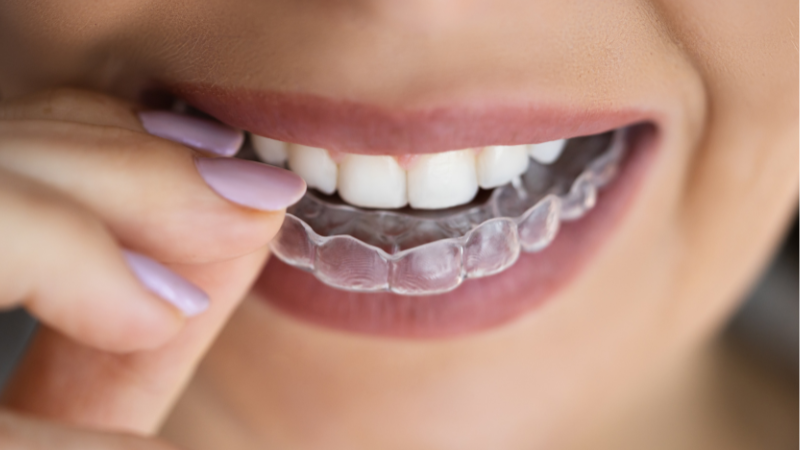
Can Clear Aligners Fix My Crowded Teeth?
April 12, 2024
Invisalign
Crowded teeth are a widespread dental issue affecting millions of individuals, characterized by overlapping, twisting, and misalignment due to insufficient space in the jaw. This condition not only impacts the aesthetic appeal of one’s smile but also hampers proper oral hygiene maintenance. Historically, metal braces served as the primary solution for straightening teeth, albeit with concerns about their conspicuous appearance. However, the advent of clear aligners has revolutionized orthodontic treatment, offering a discreet and comfortable alternative for achieving a straighter smile.
Exploring the Dynamics of Crowded Teeth
Understanding the underlying causes of crowded teeth is paramount before delving into treatment options. Several factors contribute to this misalignment:
Early Tooth Loss: Premature loss of primary teeth can disrupt the natural alignment process, leading adjacent teeth to shift and create space constraints for permanent teeth.
Supernumerary Teeth: The presence of extra teeth can disrupt the established dental arrangement, resulting in overcrowding and irregular positioning.
Habitual Influences: Prolonged habits like thumb sucking or excessive pacifier use exert pressure on teeth and jaw, prompting them to deviate from their normal positions.
Tongue Thrusting: Habitual tongue thrusting, where the tongue pushes against the teeth, can cause them to tilt forward, exacerbating crowding.
Congenital Conditions: Congenital anomalies such as cleft lip and palate can impact jaw and tooth development, contributing to crowding issues.
Implications of Crowded Teeth
Crowded teeth pose multifaceted challenges beyond cosmetic concerns, encompassing oral health, speech articulation, and psychological well-being:
Plaque Accumulation: Overlapping teeth create inaccessible areas prone to plaque buildup, increasing the risk of cavities and gum disease.
Gum Health: Untreated plaque can escalate into tartar, fostering gum inflammation and potentially progressing to periodontal disease, jeopardizing overall oral health.
Uneven Wear: Irregular tooth alignment leads to abnormal wear patterns, heightening susceptibility to dental erosion, chipping, and other structural issues.
Speech Impediments: Severe crowding can impede proper tongue placement, manifesting as speech impediments like lisps or difficulty articulating certain sounds.
Chewing Challenges: Misaligned teeth may compromise chewing efficiency, potentially culminating in digestive discomfort and temporomandibular joint (TMJ) dysfunction.
Psychological Impact: Crowded teeth often trigger self-consciousness, impacting confidence levels and interpersonal interactions negatively.
The Mechanics of Clear Aligners
Clear aligners offer a discreet and effective method for addressing crowded teeth. Here’s how they facilitate orthodontic correction:
Initial Assessment: Orthodontic professionals conduct a thorough assessment, including digital scans or X-rays, to formulate a personalized treatment plan.
Tailored Approach: Utilizing advanced software, practitioners design a customized treatment trajectory, visualizing the projected outcome and aligner progression.
Precision Fabrication: Clear aligners are meticulously crafted from durable, transparent materials, exerting gentle pressure to gradually reposition teeth over successive trays.
Progressive Adjustment: Patients wear each aligner for the prescribed duration, typically 20-22 hours daily, experiencing incremental adjustments as teeth gradually conform to their ideal alignment.
How Clear Aligners Work Their Magic
Clear aligners are a discreet and popular choice for achieving a straighter, more confident smile. But how do these seemingly simple trays achieve such remarkable results? Let’s explore the science behind clear aligner therapy:
Consultation and Digital Scans: The process begins with a consultation with an orthodontist or dentist. They assess your teeth and utilize digital scans or X-rays to create a highly detailed 3D model of your mouth. This model serves as a roadmap, enabling precise planning of each tooth’s movements throughout the treatment.
Planning for Success: Using specialized software and their expertise, the dentist develops a personalized treatment plan. This plan outlines the specific tooth movements over time, the number of aligner trays required, and the expected treatment duration. You’ll have the opportunity to visualize a projected image of your final smile, which helps maintain motivation throughout the process.
Precision Manufacturing: Based on the treatment plan, a series of custom-made clear aligners is produced for you. These aligners are typically crafted from a durable, medical-grade plastic material that is nearly invisible when worn. Each aligner is slightly different from the previous one, applying gentle and controlled pressure to specific areas of your teeth, gradually guiding them into their desired positions.
A Gradual Transformation: Each aligner tray is typically worn for 20-22 hours a day, with removal only for eating, drinking (except water), and oral hygiene. Consistent wear ensures continuous pressure on the teeth, facilitating controlled movement. As you progress through the series of aligners (usually worn for 1-2 weeks each), you’ll feel a slight tightness or pressure, indicating that the aligners are effectively guiding your teeth into place.
Can Clear Aligners Fix All Cases of Crowded Teeth?
Clear aligners are particularly effective in treating mild to moderate crowding. These transparent, removable trays gently but persistently shift your teeth into their ideal positions. Here’s how they achieve this:
Gradual Pressure: Each aligner exerts targeted pressure on the teeth, gradually moving them into alignment. This controlled movement creates space for proper positioning.
Efficient Space Creation: Clear aligners can effectively widen the dental arch, providing the necessary room for crowded teeth to align correctly.
When Clear Aligners Might Not Be Ideal
While clear aligners are highly effective, they may not be suitable for every case. Here are some scenarios where alternative treatments may be more appropriate:
Severe Crowding: In cases of extensive overcrowding or complex misalignment, clear aligners may not provide the precision required for optimal results. Traditional braces, with their brackets and wires, offer greater control for intricate tooth movements.
Limited Space: If there’s insufficient space for proper alignment, additional interventions may be necessary, even with clear aligners.
Clear aligners offer a practical solution for correcting crowded teeth, especially in mild to moderate cases. However, a consultation with an orthodontist is essential to assess the severity of your crowding and determine the most suitable treatment plan for you.





